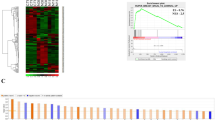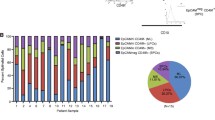Abstract
The purpose of the present study was to characterize primitive epithelial progenitor populations present in adult normal human mammary tissue using a combination of flow cytometry and in vitro colony assay procedures. Three types of human breast epithelial cell (HBEC) progenitors were identified: luminal-restricted, myoepithelial-restricted and bipotent progenitors. The first type expressed epithelial cell adhesion molecule (EpCAM), α6 integrin and MUC1 and generated colonies composed exclusively of cells positive for the luminal-associated markers keratin 8/18, keratin 19, EpCAM and MUC1. Bipotent progenitors produced colonies containing a central core of cells expressing luminal markers surrounded by keratin 14+ myoepithelial-like cells. Single cell cultures confirmed the bipotentiality of these progenitors. Their high expression of α6 integrin and low expression of MUC1 suggests a basal position of these cells in the mammary epithelium in vivo. Serial passage in vitro of an enriched population of bipotent progenitors demonstrated that only myoepithelial-restricted progenitors could be readily generated under the culture conditions used. These results support a hierarchical branching model of HBEC progenitor differentiation from a primitive uncommitted cell to luminal- and myoepithelial-restricted progenitors.
Similar content being viewed by others
References
Rudland PS: Histochemical organization and cellular composition of ductal buds in developing human breast: evidence of cytochemical intermediate between epithelial and myoepithelial cells. J Histochem Cytochem 39: 1471-1484, 1991
Rudland PS: Epithelial stem cells and their possible role in the development of the normal and diseased human breast. Histol Histopathol 8: 385-404, 1993
Stingl J, Eaves CJ, Kuusk U, Emerman JT: Phenotypic and functional characterization in vitro of a multipotent epithelial cell present in the normal adult human breast. Differentiation 63: 201-213, 1998
Stingl J, Eaves CJ, Emerman JT: Characterization of normal human breast epithelial cell subpopulations isolated by fluorescence-activated cell sorting and their clonogenic growth in vitro. J Mam Gland Biol Neoplasia (in press).
Smith GH: Experimental mammary epithelial morphogenesis in an in vivo model: Evidence for distinct cellular progenitors of the ductal and lobular phenotype. Breast Cancer Res Treat 39: 21-31, 1996
Kordon EC, Smith GH: An entire functional mammary gland may comprise the progeny from a single cell. Development 125: 1921-1930, 1998
O'Hare MJ, Ormerod MG, Monaghan P, Lane EB, Gusterson BA: Characterization in vitro of luminal and myoepithelial cells isolated from the human mammary gland by cell sorting. Differentiation 46: 209-221, 1991
Coleman S, Silberstein GB, Daniel CW: Ductal morphogenesis in the mouse mammary gland: Evidence supporting a role for epidermal growth factor. Dev Biol 127: 304-315, 1988
Snedeker SM, Brown CF, DiAugustine RP: Expression and functional properties of transforming growth factor ? and epidermal growth factor during mouse mammary gland ductal morphogenesis. Proc Natl Acad Sci USA 88: 276-280, 1992
Haslam SZ, Counterman LJ, Nummy KA: Effects of epidermal growth factor, estrogen, and progest in on DNA synthesis in mammary cells in vivo are determined by the developmental state of the gland. J Cell Physiol 155: 72-78, 1993
Yang Y, Spitzer E, Meyer D, Sachs M, Niemann C, Hartmann C, Weidner KM, Birchmeier C, Birchmeier W: Sequential requirement of hepatocyte growth factor and neuregulin in the morphogenesis and differentiation of the mammary gland. J Cell Biol 131: 215-226, 1995
Jones FE, Jerry DJ, Guarine BC, Andrews GC, Stern DF: Heregulin induces in vivo proliferation and differentiation of mammary epithelium into secretory lobuloalveoli. Cell Growth Differ. 7: 1031-1038, 1996
Slamon DJ, Clark GM, Wong SG, Levin WJ, Ullrich A, McGuire WL: Human breast cancer: correlation of relapse and survival with amplification of the HER-2/neu oncogene. Science 235: 177-182, 1987
Slamon DJ, Godolphin W, Jones LA, Holt JA, Wong SG, Keith DE, Levin WJ, Stuart SG, Udove J, Ullrich SG, Press MF: Studies of the HER-2/neu proto-oncogene in human breast and ovarian cancer. Science 244: 707-712, 1989
Koukoulis GK, Virtanen I, Horhonen M, Laitinen L, Quaranta V, Gould VE: Immunohistochemical localization of integrins in the normal, hyperplastic, and neoplastic breast. Am J Pathol 139: 787-799, 1991
Chepko G, Smith GH: Three division-competent, structurallydistinct cell populations contribute to murine mammary epithelial renewal. Tissue Cell 29: 239-253, 1997
Chepko G, Smith GH: Mammary epithelial stem cells: Our current understanding. J Mam Gland Biol Neoplasia 4: 35-52, 1999
Burchell J, Durbin H, Taylor-Papadimitriou J: Complexity of expression of antigenic determinants recognized by monoclonal antibodies HMFG-1 and HMFG-2 in normal and malignant human mammary epithelial cells. J Immunol 131: 508-513, 1983
Spangrude GJ, Johnson GR: Resting and activated subsets of mouse multipotent hematopoietic stem cells. Proc Natl Acad Sci USA 87: 7433-7437, 1990
Udomsakdi C, Eaves CJ, Sutherland HJ, Lansdorp PM: Separation of functionally distinct subpopulations of primitive human hematopoietic cells using rhodamine-123. Exp Hematol 19: 338-342, 1991
Ronot X, Paillasson S, Muirhead KA: Assessment of cell viability in mammalian cell lines. In: Grogan WM, Collins JM (eds) Guide to Flow Cytometry. M Dekker, New York, 1990, pp 177-192
Richards J, Larson L, Yang J, Guzman R, Tomooka Y, Osborn R, Imagawa W, Nandi S: Method for culturing mammary epithelial cells in a rat tail collagen gel matrix. J Tissue Cult Meth 8: 31-36, 1983
Johnston CS, Shpall EJ, Williams S, Hami L, Jones RB, Bast RC, Ceriani RL, Franklin W: Detection of minimal residual breast cancer in bone marrow. In: Worthington-White DA, Gee AP, Gross S (eds) Advances in Bone Marrow Purging and Processing. Wiley-Liss, New York, 1992, pp 637-642
Pechoux C, Gudjonsson T, Ronnov-Jessen L, Bissell MJ, Petersen OW: Human mammary luminal cells contain progenitors to myoepithelial cells. Dev Biol 206: 88-99, 1999
Kao C-Y, Nomata K, Oakly CS, Welsch CW, Chang C-C: Two types of normal human breast epithelial cells derived from reduction mammoplasties: Phenotypic characterization and response to SV40 transfection. Carcinogenesis 16: 531-538, 1995
Kang K-S, Morita I, Cruz A, Young JJ, Trosko JE, Chang C-C: Expression of estrogen receptors in a normal breast epithelial cell type with luminal and stem cell characteristics and its neoplastically transformed cell lines. Carcinogenesis 18: 251-257, 1997
Bailey ME, Brown RW, Mody DR, Cagle P, Ramzy I: Ber-EP4 for differentiating adenocarcinoma from reactive and neoplastic mesothelial cells in serous effusions. Comparison to carcinoembryonic antigen, B72. 3 and Leu-M1. Acta Cytol 40: 1212-1216, 1996
Delahaye M, van der Ham F, van der Kwast TH: Complementary value of five carcinoma markers for the diagnosis of malignant mesothelioma, adenocarcinoma metastasis, and reactive mesothelium is serous effusions. Diag Cytopath 17: 115-120, 1997
Sebastian J, Richards RG, Walker MP, Wiessen JF, Werb Z, Derynck R, Hom YK, Cunha GR, DiAugustine RP: Activation and function of the epidermal growth factor receptor and erB-2 during mammary gland morphogenesis. Cell Growth Differ 9: 777-785, 1998
Wiesen JF, Young P, Werb Z, Cunha GR: Signaling through the stromal epidermal growth factor receptor is necessary for mammary ductal development. Development 126: 335-344, 1998
Ferguson DJP: An ultrastructural study of mitosis and cytokinesis in normal ‘resting’ human breast. Cell Tissue Res 252: 581-587, 1988
Bartek J, Taylor-Papadimitriou J, Miller N, Millis R: Patterns of expression of kerat in 19 as detected with monoclonal antibodies in human breast tissues and tumors. Int J Cancer 36: 299-306: 1985a
Bartek J, Durban EM, Hallowes RC, Taylor-Papadimitriou J.: A subclass of luminal epithelial cells in the human mammary gland, defined by antibodies to cytokeratins: J Cell Sci 75: 17-33, 1985b
Bocker W, Bier B, Freytag G, Brommelkamp B, Jarasch E-D, Edel G, Dockhorn-Dworniczak B, Schmid KW: An immunohistochemical study of the breast using antibodies to basal and luminal keratins, alpha-smooth muscle actin, vimentin, collagen IV and laminin. Part I: normal breast and benign proliferative lesions. Virchows Archiv A [Pathol Anat] 421: 315-322, 1992
Niranjan B, Buluwela L, Yant J, Perusinghe N, Atherton A, Phippard D, Dale T, Gusterson B, Kamalati T: HGF/SF: a potent cytokine for mammary growth, morphogenesis and development. Development 121: 2897-2908, 1995
Hirai Y, Lochter A, Galosy S, Koshida S, Niwa S, Bissell MJ: Epimorphin functions as a key morphoregulator for mammary epithelial cells. J Cell Biol 140: 159-169, 1998
Coleman S, Daniel CW: Inhibition of mouse mammary ductal morphogenesis and down-regulation of the EGF receptor by epidermal growth factor. Dev Biol 137: 425-433, 1990
O'Hare MJ, Ormerod MG, Monaghan P, Cooper CS, Gusterson BA: Differentiation and growth in the human breast parenchyma. Biochem Soc Trans 17: 589-591, 1989
Gompel A, Martin A, Simon P, Schoevaert D, Plu-Bureau G, Hugol D, Audouin J, Leygue E, Truc JB, Poitout PH: Epidermal growth factor receptor and c-erbB-2 expression in normal breast tissue during the menstrual cycle. Breast Cancer Res Treat 38: 227-235, 1996
Jones PH, Watt FM: Separation of human epidermal stem cells from transit amplifying cells on the basis of differences in integrin function and expression. Cell 73: 713-724, 1993
Jones PH, Harper S, Watt FM: Stem cell patterning and fate in human epidermis. Cell 80: 83-93, 1995
Edwards PAW, Brooks IM: Antigenic subsets of human breast epithelial cells distinguished by monoclonal antibodies. J Histochem Cytochem 32: 531-537, 1984
Purkis PE, Steel JB, Mackenzie IC, Nathrath WBJ, Leigh IM, Lane EB: Antibody markers of basal cells in complex epithelia. J Cell Sci 97: 39-50, 1990
Gusterson BA, Monaghan P, Mahendran R, Ellis J, O'Hare MJ: Identification of myoepithelial cells in human and rat breasts by anti-common acute lymphoblastic leukemia antigen antibody A12. J Natl Cancer Inst 77: 343-349, 1986
Author information
Authors and Affiliations
Rights and permissions
About this article
Cite this article
Stingl, J., Eaves, C.J., Zandieh, I. et al. Characterization of bipotent mammary epithelial progenitor cells in normal adult human breast tissue. Breast Cancer Res Treat 67, 93–109 (2001). https://doi.org/10.1023/A:1010615124301
Issue Date:
DOI: https://doi.org/10.1023/A:1010615124301




